Presses: Front deltoid
Behind the neck press
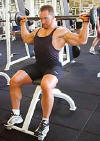 
Lower the bar to ear level and press it straight up from that point. Do not push the head back as you press the bar up.
Overhead press
 
Keep the bar slightly in front of you, and push it straight up over the start point. Lower the bar to ear level only. Pull the elbows slightly in front of your body.
Dumbbell press
 
Begin the exercise with the dumbbells at ear level and press them up and together at the conclusion.
Machine overhead press
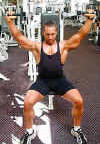 
Pull the elbows slightly in front of your body.
Front lateral raise
1)
2)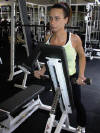 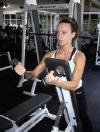
shown leaning forward on bench using supinated grip
Rear deltoid
Bent over laterals
 
This exercise works the back portion of the upper shoulders; the rear head of the deltoids. It’s a difficult exercise in that it demands patience and attention to form. The back is horizontal and parallel to the floor throughout the movement. The arms maintain a constant bend at the elbows that does not change. : Keep the weight low enough so your form is perfect and you’ll find that the rear portion of your shoulder develops nicely and prevents a stooped or forward-lean look. Start with the dumbbells in front of your head and slowly raise them to the side, pausing for a second before you lower them.
One arm cable rear lateral
 
Kneeling on the floor, arm bent slightly. Pull the handle out to your side, pivoting at the shoulder joint, not the elbow joint.
Rear deltoid machine
 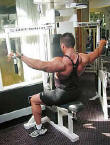
This particular machine allows the hands to begin near each other and then pull back and spread, increasing the distance between them, as the contraction is completed. Try to feel the rear portion of the shoulder do the work and avoid using momentum as an aid once you’ve begin to pull the weight back.
Bent over arm swing
 
Shown leaning forward on bench. Pull the shoulder blades back at the top of each rep.
Standing: bent over at a 90 degree angle with your back flat (not rounded, stick your butt out and your shoulders back), keeping your arms straight, pull them back to your sides and pull your shoulder blades together at the top. You should be squeezing your rear deltoids, the muscles just above your triceps.
Combination / sports
Power cleans
 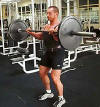 
|
|
Lateral deltoid
Side lateral raises
 
 
On all lateral raises: Maintain a constant bend at the elbow that does not change during the movement. This keeps the exercise and its emphasis on the outside head of the deltoid consistent.
Bent arm laterals
 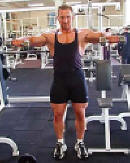
Slightly easier version.
Leaning cable lateral
 
Lean towards the working side, grasping a bar for stability. This prevents leaning into the exercise and isolates the deltoid. Note that the arm is slightly cocked at the beginning of the exercise, preloading for tension, and raise hand to eye level.
Side lateral machine
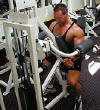 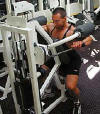
Pull your elbows back while holding the handles to maximize work on the lateral deltoid.
Side lateral raise option
 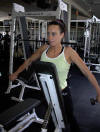
shown leaning forward on bench
Upright rows
 
The hands are between 6-12" apart. Keep your back straight or you can create unnecessary strain on the lower back. Keep your elbows above your hands at all times, and don’t let your arms straighten completely when they come below the waist. Hold the bar 6-12 inches out from your body to focus on deltoid width.
Wide grip upright rows
 
Push the elbows out in front of you so the forearm is perpendicular to the floor. If you are doing this one correctly, you will only be able to raise your upper arms to parallel with the floor and no higher. Do not pull the elbows back to get the bar higher. This is an advanced technique to accentuate the side deltoids.
Dumbbell upright rows
 
Keep the dumbbells well in front of the body to get over the chest.
Cable upright rows
 
Cable upright rows have more of a tendency to work the trapezius due to the angle of the cable.

Standard deltoid supersets

Don Ross' shoulder blast giant set
|
